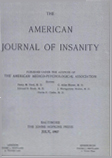HUMAN BRAIN METABOLISM
Abstract
The metabolism of the brain was studied in normal, schizophrenic, paretic and senile subjects, and the effect of alcohol, paraldehyde and morphine was studied. Arterio-venous differences for oxygen, carbon dioxide, glucose and lactic acid were determined by means of internal jugular puncture. The observations support the following conclusions:
1. The O2 arterio-venous difference of the brain in schizophrenics, both before and after insulin therapy, is normal.
2. In general paresis the O2 arterio-venous difference of the brain shows a slight diminution of questionable significance.
3. The O2 arterio-venous difference of the brain in patients with cerebral arteriosclerosis is normal, but their systemic circulation is somewhat slow. This would indicate a reduced brain metabolism.
4. The O2 arterio-venous difference in chronic alcoholism tends to be higher than normal and is associated with an elevated arterial glucose level.
5. Alcohol and morphine diminish the O2 arterio-venous difference of the brain.
6. In therapeutic doses paraldehyde did not diminish the O2 arterio-venous difference of the brain of chronic alcoholic patients.
Access content
To read the fulltext, please use one of the options below to sign in or purchase access.- Personal login
- Institutional Login
- Sign in via OpenAthens
- Register for access
-
Please login/register if you wish to pair your device and check access availability.
Not a subscriber?
PsychiatryOnline subscription options offer access to the DSM-5 library, books, journals, CME, and patient resources. This all-in-one virtual library provides psychiatrists and mental health professionals with key resources for diagnosis, treatment, research, and professional development.
Need more help? PsychiatryOnline Customer Service may be reached by emailing [email protected] or by calling 800-368-5777 (in the U.S.) or 703-907-7322 (outside the U.S.).



